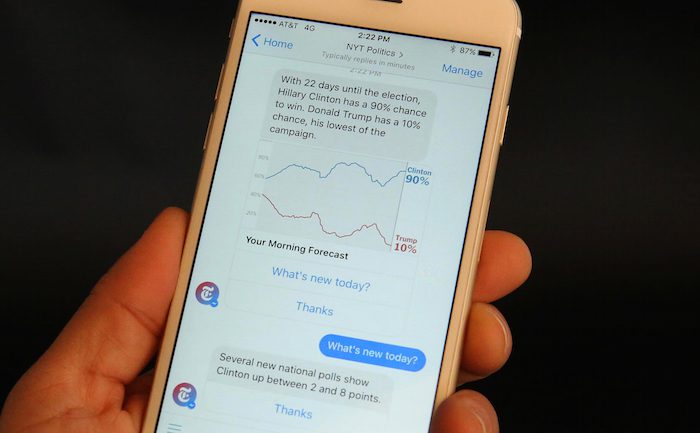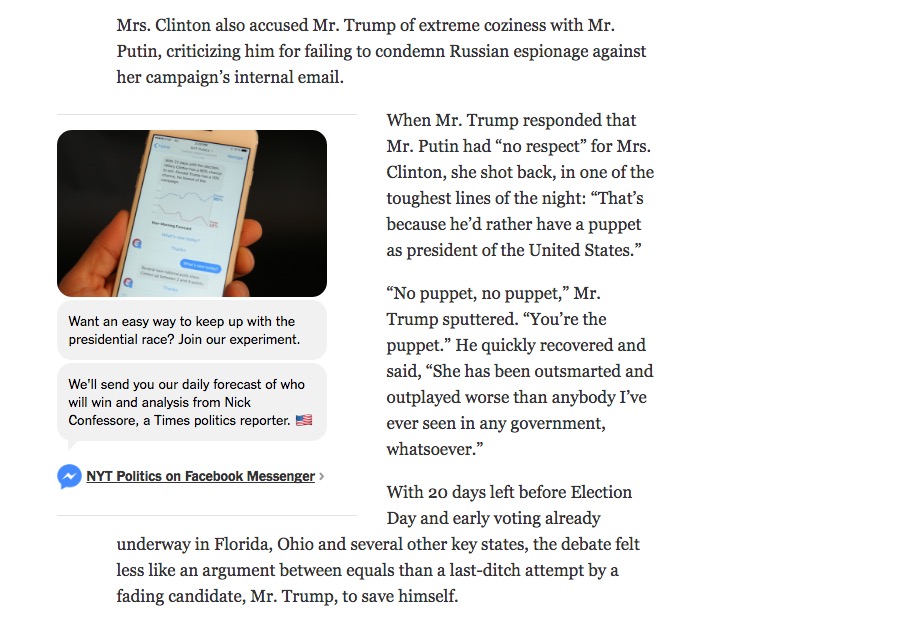
The New York Times on Wednesday released a Facebook Messenger bot to cover the last 19 days of the U.S. presidential election. The bot combines automated updates with dispatches from political reporter Nicholas Confessore.
Each morning, the bot sends users a message with its latest presidential election forecast (which may be a calming or unnerving way to start your day, depending on your political point of view). Users can also ask the bot for the Times’ projections for each state and a survey of recent national polls.
Now for something a little different:
Today through Election Day, daily FB analysis from me–direct to you! Signup: https://t.co/8qvtXC9dBi pic.twitter.com/ZBwqcLvRh4— Nick Confessore (@nickconfessore) October 20, 2016
Some publishers, such as CNN and The Wall Street Journal, were quick to jump onto Messenger after Facebook introduced bots last spring, but others, including the Times, have taken a more wait-and-see approach to the platform and messaging in general.How it'll work: Me and @UpshotNYT's election model will shoot you daily analysis and insight. There's a Choose Your Own Adventure element. pic.twitter.com/d4b1wBgEHy
— Nick Confessore (@nickconfessore) October 20, 2016
It’s unclear how many people actually want to use Messenger for news. In July, Facebook said more than 11,000 bots have been created for the platform, and many users have noted that there are often easier ways to find news or information.
Still, the Times is heavily promoting the bot in its apps and on its website. Links to sign up for the bot are included in the paper’s coverage of last night’s presidential debate.

“If you think about the other text conversations that show up on your lock screen — it’s your mom, it’s your significant other, it’s your friend. I think that if we can be there its a really powerful relationship that we can create,” Phelps said. “We can essentially create these little moments in your life and reconnect you to us and, hopefully, viewing it from more of a product perspective, bring you back to our core platforms to read more of our journalism.”
The politics Messenger bot seems like its trying to follow a similar approach by mixing the automated forecasts with Confessore’s more conversational updates. Marc Lavallee, then the Times’ editor of interactive news, said in August that messaging platforms could allow the paper to talk with many people at once in a way that feels intimate and personal.
“What we’re trying to do,” he said, “is figure out if there a space between broadcast, where everyone gets the same exact thing, and a total human-powered one-on-one interaction — which obviously doesn’t scale easily — to see if we can have the best of both worlds.”